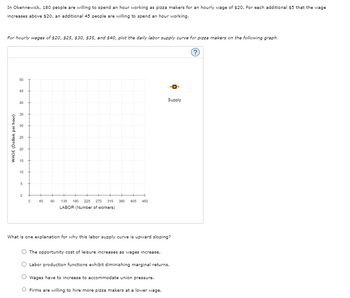
ENGR.ECONOMIC ANALYSIS
14th Edition
ISBN: 9780190931919
Author: NEWNAN
Publisher: Oxford University Press
expand_more
expand_more
format_list_bulleted
Question

Transcribed Image Text:In Okennewick, 180 people are willing to spend an hour working as pizza makers for an hourly wage of $20. For each additional $5 that the wage increases above $20, an additional 45 people are willing to spend an hour working.
**Plot the Daily Labor Supply Curve:**
For hourly wages of $20, $25, $30, $35, and $40, plot the daily labor supply curve for pizza makers on the following graph.
**Graph Description:**
- **Y-axis:** WAGE (Dollars per hour)
- **X-axis:** LABOR (Number of workers)
The graph is a blank plot intended for students to draw the supply curve. The supply curve will be upward sloping, starting at 180 workers for $20 and increasing by 45 workers for each $5 increase in wages.
**Question:**
What is one explanation for why this labor supply curve is upward sloping?
- The opportunity cost of leisure increases as wages increase.
- Labor production functions exhibit diminishing marginal returns.
- Wages have to increase to accommodate union pressure.
- Firms are willing to hire more pizza makers at a lower wage.
Expert Solution
This question has been solved!
Explore an expertly crafted, step-by-step solution for a thorough understanding of key concepts.
This is a popular solution
Trending nowThis is a popular solution!
Step by stepSolved in 4 steps with 1 images

Knowledge Booster
Learn more about
Need a deep-dive on the concept behind this application? Look no further. Learn more about this topic, economics and related others by exploring similar questions and additional content below.Similar questions
- Since 1960, the earnings gap between men and women in the U.S. labor market has O steadily risen. O been completely eliminated. O continued to narrow. O increased throughout the 1970s.arrow_forwardRead the "Clear it Up: Do Profit Maximizing Employers Exploit Labor" Do Profit Maximizing Employers Exploit Labor? (Source: OER) If you look back at the labor dynamics of supply and demand, you will see that only the firm pays the last worker it hires what they’re worth to the firm. Every other worker brings in more revenue than the firm pays him or her. This has sometimes led to the claim that employers exploit workers because they do not pay workers what they are worth. Let’s think about this claim. The first worker is worth $x to the firm, and the second worker is worth $y, but why are they worth that much? It is because of the capital and technology with which they work. The difference between workers’ worth and their compensation goes to pay for the capital, technology, without which the workers wouldn’t have a job. The difference also goes to the employer’s profit, without which the firm would close and workers wouldn’t have a job. The firm may be earning excessive profits,…arrow_forwardWhich of the following is not an assumption of a competitive labor market? O numerous buyers and sellers O interchangeable workers accurate and widely available information workers preferable to machinesarrow_forward
- Show in schedule form and graphically the labor demand curve of this firm.arrow_forwardMarginal revenue product of labor 56 48 $36 40 36 28 20 11 0 O 12 cake pops 36 cake pops $144 1 2 3 4 5 6 The Figure shows the marginal revenue product (also called the value of the marginal product) for Cora's Confections, a producer of hand-made cake pops. If Cora can sell her cake pops at $3 each, what is the marginal product of the 4th worker? 7 Marginal revenue product of labor Quantity of laborarrow_forwardTable 14.10 shows levels of employment (Labor), the marginal product at each of those levels, and the price at which the firm can sell output in the perfectly competitive market where it operates. a. What is the value of the marginal product at each level of labor?b. If the firm operates in a perfectly competitive labor market where the going market wage is $12, what is thefirm’s profit maximizing level of employment?arrow_forward
arrow_back_ios
arrow_forward_ios
Recommended textbooks for you

 Principles of Economics (12th Edition)EconomicsISBN:9780134078779Author:Karl E. Case, Ray C. Fair, Sharon E. OsterPublisher:PEARSON
Principles of Economics (12th Edition)EconomicsISBN:9780134078779Author:Karl E. Case, Ray C. Fair, Sharon E. OsterPublisher:PEARSON Engineering Economy (17th Edition)EconomicsISBN:9780134870069Author:William G. Sullivan, Elin M. Wicks, C. Patrick KoellingPublisher:PEARSON
Engineering Economy (17th Edition)EconomicsISBN:9780134870069Author:William G. Sullivan, Elin M. Wicks, C. Patrick KoellingPublisher:PEARSON Principles of Economics (MindTap Course List)EconomicsISBN:9781305585126Author:N. Gregory MankiwPublisher:Cengage Learning
Principles of Economics (MindTap Course List)EconomicsISBN:9781305585126Author:N. Gregory MankiwPublisher:Cengage Learning Managerial Economics: A Problem Solving ApproachEconomicsISBN:9781337106665Author:Luke M. Froeb, Brian T. McCann, Michael R. Ward, Mike ShorPublisher:Cengage Learning
Managerial Economics: A Problem Solving ApproachEconomicsISBN:9781337106665Author:Luke M. Froeb, Brian T. McCann, Michael R. Ward, Mike ShorPublisher:Cengage Learning Managerial Economics & Business Strategy (Mcgraw-...EconomicsISBN:9781259290619Author:Michael Baye, Jeff PrincePublisher:McGraw-Hill Education
Managerial Economics & Business Strategy (Mcgraw-...EconomicsISBN:9781259290619Author:Michael Baye, Jeff PrincePublisher:McGraw-Hill Education


Principles of Economics (12th Edition)
Economics
ISBN:9780134078779
Author:Karl E. Case, Ray C. Fair, Sharon E. Oster
Publisher:PEARSON

Engineering Economy (17th Edition)
Economics
ISBN:9780134870069
Author:William G. Sullivan, Elin M. Wicks, C. Patrick Koelling
Publisher:PEARSON

Principles of Economics (MindTap Course List)
Economics
ISBN:9781305585126
Author:N. Gregory Mankiw
Publisher:Cengage Learning

Managerial Economics: A Problem Solving Approach
Economics
ISBN:9781337106665
Author:Luke M. Froeb, Brian T. McCann, Michael R. Ward, Mike Shor
Publisher:Cengage Learning

Managerial Economics & Business Strategy (Mcgraw-...
Economics
ISBN:9781259290619
Author:Michael Baye, Jeff Prince
Publisher:McGraw-Hill Education